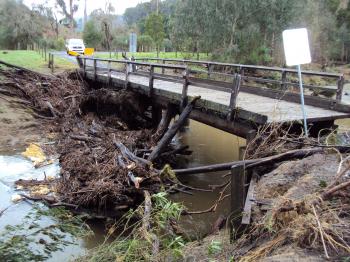The changing nature of our climate and rise in extreme weather events is acknowledged both nationally and internationally as a growing risk. In its Global Risks Report 2013, the World Economic Forum identified the environment and need for resilience as one of its three major risk cases.
In recent years the Barwon South West Region (the Region) has experienced a number of extreme weather events, ranging from flooding and storms through to extreme heat, often resulting in bushfires.

Figure 2: Stevenson Falls access bridge following flooding of the Gellibrand River in 2010
For example, the Southern Grampians experienced extensive bushfires in early 2013 as well as bushfires across the Region in 2011. There have been storm surges and subsequent flooding along parts of the Great Ocean Road such as in 2009. Flooding due to extreme rainfall events has occurred in numerous locations including the Kennett River and Gellibrand River in Colac Otway and along Mt Emu Creek in Corangamite in 2010 and 2011. In addition the Region has experienced heatwaves in 2009, 2013 and more recently in early 2014 when record temperatures were experienced. These are just a few examples of the weather events across the Region and shows that the Region is already experiencing some of the events investigated and forecast in this project.
The variety, frequency and geographical spread of these events, combined with projected future climatic conditions, highlight the urgency for the Region to build resilience and adaptive capacity into the future. There is broad recognition between councils, service providers and industry in this Region of the importance of building the resilience of communities, the environment and industry to better cope with a harsher future.
In the Victorian context, there are specific pieces of legislation which include a range of compliance obligations that are relevant to building resilience to climate change and emergency management. These Acts include the Emergency Management Act 1986, Country Fire Authority Act 1958, Public Health and Wellbeing Act 2008, Water Act 1989, Water Industry Act 1994 and the Electricity Safety Act 1998.
Councils are required to create a Health and Wellbeing Plan within 12 months of council elections. The Plan must consider climate change, and subsequently be incorporated into the council or strategic plan. Additionally, climate change and its potential impacts must be taken into account as part of the decision making process under a range of Acts, including those covering catchment and land protection, coastal management, environmental protection, flora and fauna and water.
The most notable legislative response in relation to climate change adaptation across Australia is around emergency and fire management. Councils have a number of requirements placed on them through statutory instruments in order to prevent and manage fires and emergencies. This is through the appointment of relevant officers, committees and the development of prevention/management plans.
But compliance is not enough. To better manage these climatic risks, the Victorian Government introduced its first Climate Change Adaptation Plan in 2013. This recognises that Victoria’s local governments have an important role to play in climate adaptation. The Government is renewing its commitment to its partnership with the local government sector through the Victorian Adaptation and Sustainability Partnership – Supporting Local Climate Resilience (formerly the Victorian Local Sustainability Accord).
“Adaptation is about increasing public and private resilience to climate risks through better decisions about managing our built and natural environment and taking advantage of opportunities. Victoria’s liveability is defined by the health and beauty of our natural environment, the quality of our infrastructure and the strength of our economy. Changes in our climate may put each of these assets under pressure if we don’t act to protect them.” (Victorian Government, 2013)
Actions on resilience building as recommended by better practice also include:
- Incorporating the latest climate change risks within existing risk management frameworks
- Leveraging community consultation and engagement processes to build awareness of risks and challenges
- Considering climate change resilience building within community programs
- Building climate risk into infrastructure and building investment.
Introduction
The project and stakeholders








